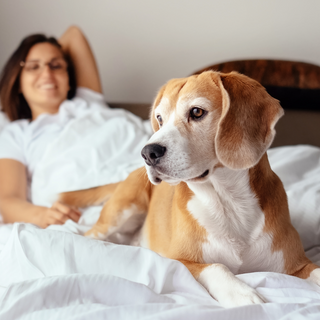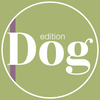Calming conversations
Words Pennie Clayton: Canine Behaviour and Training & Canine Bowen Therapist
Just because dogs are unable to form actual words does not mean that they do not communicate with us. Pennie Clayton explains more.
Dog language is no less complex than ours. Just because dogs are unable to form actual words does not mean that they don’t communicate. The longer puppies spend with their mothers and siblings the better they get at recognising and acting on the information they receive in their initial weeks. Not only is puppyhood a very important part of a dogs’ life as far as development and growing is concerned, it is crucial to communication and these early conversations are essential.
A good mother will teach her puppies, and will indeed discipline them, but only as needed, and no more than is necessary, the interaction between siblings also provides crucial life lessons. In a healthy litter of puppies with a good mother by the time they go home at 9-12 weeks they will be well on the way to being fluent in “dog speak”. But there is a problem, so few humans recognise or respond to what their young dogs are trying to tell them that these communications are often ignored.
Pictures often depict puppies being lifted up and cuddled by children, but you only have to look carefully at the picture to see that they are often uncomfortable and frightened. Being picked up and hugged may be something dogs learn to enjoy, but it is clear in their eyes and their bodies if something is not acceptable and is causing them distress.
What do we need to know? Firstly, we need to know that their communication is clear, but not always evident to those who have not studied it in detail. As humans we all have to learn how to communicate and how to reply in return, and this in return should be an essential part of our research before we take on the role of guardians to our own dogs.

We need to know that there are three distinct “zones”. These are often termed green, amber and red, just like a traffic light system. Most people recognise and have an opinion about barking, snarling, and growling but not enough people know that before this point many things occur. Dogs would always choose to maintain calm interactions, and this is how they prefer to live their lives. Constant confrontation is tiring and expensive in energy terms and given the choice calm interactions are infinitely preferable to our dogs.
The obvious “aggressive looking behaviours” are recognised so easily that dogs get bad press for exhibiting them, but nowhere near as much attention is paid to the majority of dogs that work hard to maintain peaceful interactions. Not enough people understand that a lip lick or a dog turning his head away, as another dog approaches, are invaluable tools and help to maintain clarity and peaceful meetings. The reason many people miss these clear and undiluted signals is because they are very brief; they rarely last more than a second or two.
If a dog pauses before greeting another dog the owner can sometimes be heard to remonstrate that the dog is being a bit “standoffish” or unfriendly. This could not be further from the truth, a slow approach with a turned head, and a pause, signals quite the opposite, this is very good respectful communication. The dog that is displaying these is conveying that he means no harm and is checking the dog he is moving towards is comfortable before the distance is decreased between them. This is clear and good dog etiquette, even if the humans that are involved are ignorant of the subtleties.
The concept of calming signals was first aired by Turid Rugaas; as she observed dogs she realised they were responding to each other in very specific ways. She identified more than 60 different signals which have now become familiar the world over and have contributed to an enormous interest in dog communication.
She recognised that dogs if left to interact without interference, would always choose to stay in the “green area” as this signals peaceable and stress free interactions, this also prevents injury and attack. Very few dogs would wish to inflict harm or put themselves in a threatening situation. As a dog turns his head, other dogs in the immediate vicinity recognise the need to pause and curve around and give each other the freedom to approach each other (or not) depending on the feedback they receive.

This considered communication takes seconds and dogs should always be allowed to spend a few moments assessing situations for themselves. A dogs’ choice would always be to greet in a calm and reflective way, as we are taught to do from a young age when meeting unfamiliar people. If the initial approach is both respectful and non-threatening, it can produce strong friendships. After a good introduction, dogs can become firm friends without the need for the primary greetings. A successful initial meeting is key to forming any strong friendships.
People on the other hand often encourage dogs to meet both on and off lead which can lead to many problems and escalations. Communication also involves body posture, a dog that tenses as he spots another dog will not have a relaxed attitude towards other dogs rushing up. The value of two-way communication cannot be underestimated, it should be the dogs that decide what happens next, not us.
We may miss the fact that a situation may be escalating from green, to amber (this includes the hackles being raised, increased tension in body, low grumbling) the more vocal and noticeable the communication is between dogs the more we should be on alert. Dogs that resort to barking, lunging and biting, are not only very anxious, but they have somehow learnt that escalation is an option and may bypass all the important introductory steps, the fault here often lies at the feet of human handlers.
Big and noisy interactions are designed to get the attention of other dogs, and primarily exist as defensive manoeuvres, they signal severe discomfort and serve to tell approaching dogs about how threatened they are feeling. There are few dogs that have the intention of hurting another dog, because the risk of injury to themselves is so great. No dog wants to put himself intentionally in a place where he could be wounded so severely that there is a chance he will die. Our role in this should never be to dole out punishment, however shocked and frightened we are, because it is the fastest way to escalate a situation. Punishing vocal or aggressive looking behaviours is the worst course of action we could ever take, as well as being the fastest way to get bitten, or to initiate an attack, as the alternatives have been denied. Insisting that dogs “get on” is not the way to promote good relationships between dogs.

It is up to us to think about how dogs would choose to greet each other. Dogs are evidently another species apart from ourselves. They do not relish a constant state of conflict either in the home or when out walking, especially if this is instigated by the human on the end of a lead.
How do we learn to become more skilled at interpreting our dogs’ language? It is easy. We learn to watch and we need to help by being aware that many situations can be negative. Do not dismiss anything you see. Look for dogs slowing down as they spot each other, watch how much they sniff the ground as they approach each other; they have amazing skills which are incredibly diplomatic if we allow them. A dipping of the head lowers posture, keeps the body neutral, and lowers the pulse rate. Apart from the obvious need to take the world in through their noses this is also a very clear set of calming signals. This is often reciprocated by others dog in the nearby area, this opens the door to a proper and closer introduction. They may then carefully move closer and quietly circle each other and progress to a brief bottom sniff before they move away, this is good communication, and great socialisation.
When a puppy starts to investigate the world, adult dogs are almost always very kind to them. An adult dog recognises that a puppy is not as well versed in socialisation and may make mistakes, and the mature dog will make allowances; that is until the puppy is around 6 months old. After this point an adult dog will start to object to baby behaviour; in an adult dogs eyes a puppy becomes responsible for his actions at this age. An older dog that has been kind and “turned the other cheek” will often respond very differently after this deadline. In our dogs’ world, a puppy licence expires at six months, intrusive actions are not well tolerated after this, and may result in a swift telling off about rough play and behaviours. This is part of growing up for all dogs. It is no good getting upset at what might look like very brusque behaviour on part of the previously very good natured adult dog, it is just part of growing up.
- Choosing a selection results in a full page refresh.



1 comment
Delia Lefley
We inherited our latest goldie from our breeder. She was not sold because of ill health and lived with various dog relatives and her by then elderly owner, walked regularly but not socialised much. She was in a loving home, which collapsed on the death of her owner, dog granny etc. she came to us at 6 years and we quickly discovered she loves humans but has very little idea on how to interact with dogs, bouncing up like a teenager to some, ignoring others and actually scrapping with others. It’s very difficult to gauge what will happen so we have various strategies which work most times. She is normally very calm and much admired for her polite behaviour. I guess she’s work in progress, and I hope people won’t jump to the wrong conclusions when they don’t know her background.
Very useful article otherwise!